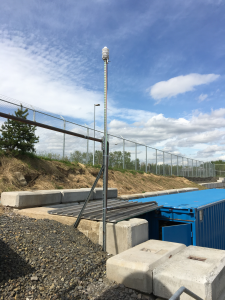How It Works
Pumps, pipes, air compressor, sensors and computers each play a role in sampling stormwater at the STTC.

- Several weather stations have been installed within the watershed for collecting meteorological data including precipitation, barometric pressure, humidity, temperature, wind speed and direction. In conjunction with rainfall event forecasts, the data will be used by monitoring staff at the STTC to determine when a rainfall event will provide adequate volumes of stormwater for sampling. One station is located adjacent to the STTC control room and another station is located approximately two miles northwest of the STTC on the Glisan Street exit 21A sign (I-5). The weather station at Portland International Airport which is approximately two miles northwest of the STTC will also be used.
- Stormwater from rainfall events is collected by drainage inlets along the city streets and highways from across the entire 1,000 acre watershed. The storm drain system conveys the stormwater through larger and larger pipes as it flows downstream.
- The stormwater is diverted from the 7-foot drainage pipe to a large manhole called the Feed Wet Well (FWW).
- Pump #0 recirculates the stormwater and the debris in the FWW so a representative sample of the pollutants is available.
- Piping in the FWW delivers stormwater to the STTC’s Test Bays via gravity flow or pumping. The diameter of the pipes vary from 2” to 4”, depending on the desired flow rate and ensures flow velocity is fast enough to keep larger sediment and other debris is suspension as it is carried to the Test Bays. Clear PVC pipe and hoses are used so flow can be visually monitored and easily identify needed repairs.
- The Programmable Logic Controller (PLC) performs two key tasks. 1) it controls Pneumatic Valves in order to match the suction pipe diameter to the pump speed that will produce the required velocity in the pipes for keeping sediment in suspension. 2) It also monitors the water surface in the Test Bays with Guided-Wave Level Sensors. These sensors determine if too much water is being sent to the stormwater treatment technology being tested. If the water level is rising and the technology is about to go into bypass, the PLC slows the dosing flow rate to the technology. The PLC sends data on all the tasks it performs and all the water surface and pump flow rate data to the SCADA program for archiving and Data Acquisition (SCADA) system allows the operators of the STTC to remotely monitor and control the multiple stormwater pumps, flow control valves, and samplers at the facility.
- Vacuum Samplers pull samples of the raw stormwater into sample-jars. High velocity streams of water are necessary during the sampling process to suspend and carry sediment to the sample-jars.
- Influent and effluent stormwater samples are then sent to a laboratory for analysis. Data from laboratory analysis of the pollutant concentrations in these samples are used to determine the removal efficiency of the stormwater treatment technology being tested.
The STTC is the first facility approved by the Washington State Department of Ecology for testing pursuant to the Technology Assessment Protocol – Ecology (TAPE) program that utilizes pumps to deliver stormwater to a treatment technology for quantifying its pollutant removal efficiency. The STTC is also the first center specifically designed to evaluate the maintenance requirements and parallel testing of up to three technologies simultaneously make the STTC’s operational functionality a national model. In the future, the STTC may be used to test for a variety of pollutants and contaminants landed to support additional Test Bays to the north of the existing facility.
